-
01-01-2016
Modified early warning score: evaluation of trauma patients
Revista Brasileira de Enfermagem. 2016;69(5):906-911
Abstract
Modified early warning score: evaluation of trauma patients
Revista Brasileira de Enfermagem. 2016;69(5):906-911
DOI 10.1590/0034-7167-2015-0145
Views0See moreABSTRACT
Objective:
to identify the severity of patients admitted to an emergency trauma.
Method:
A cross-sectional and retrospective study with 115 trauma patients classified as orange (Manchester System), from June 2013 to July 2014. The data were presented as mean and standard deviation, in addition to the Pearson Chi-square test, One-Way ANOVA and Tukey tests.
Results:
from the sample, 81.7% were male with mean age of 39.46±19.71 years. Higher incidence of major trauma (48.7%) and traumatic brain injury (37.4%). At the end of the outcome and MEWS, most cases that had score 1 to 3 were referred to the operating room and the ICU.
Conclusion:
the start point of MEWS was 2 to 3 points, with significant increase in the severity of the situation of patients seen after 6 hours, and approximately half of the individuals underwent surgery, indicating that the scale is a good predictor of severity.
-
01-01-2016
Occupational health nurses: interdisciplinary experience in occupational health
Revista Brasileira de Enfermagem. 2016;69(5):897-905
Abstract
Occupational health nurses: interdisciplinary experience in occupational health
Revista Brasileira de Enfermagem. 2016;69(5):897-905
DOI 10.1590/0034-7167-2015-0113
Views0See moreABSTRACT
Objective:
to analyze the relationship of occupational health nurses with the other members of the Specialized Service in Safety Engineering and Occupational Medicine (SESMT) and characterize joint actions of these professionals in occupational health.
Method:
qualitative, exploratory, and descriptive study with 34 professionals of seven companies from the South Macroregion of the state of Rio Grande do Sul. Interviews and observations were conducted for content analysis of Bardin.
Results:
the SESMTs are multidisciplinary and intersectoral workers. Nurses have working relations of an interpersonal, technical/legal, and management of logistics/organizational nature, influenced by the technical division of work and by the division in the work environment of the staff, which distances areas, generates conflicts, and fragments the actions of the service.
Conclusion:
SESMT faces challenges to develop a work befitting their legal objectives, once staff and companies need to understand the importance of interdisciplinarity for the success of actions on the workers’ health and safety.
-
01-01-2016
Translation and adaptation of a pediatric early warning score
Revista Brasileira de Enfermagem. 2016;69(5):888-896
Abstract
Translation and adaptation of a pediatric early warning score
Revista Brasileira de Enfermagem. 2016;69(5):888-896
DOI 10.1590/0034-7167-2015-0096
Views0See moreABSTRACT
Objective:
to translate and adapt the BPEWS for the Portuguese language, with the purpose of verifying its applicability in the Brazilian context studied.
Method:
methodological study guided by international and nationally accepted recommendations for translation and adaptation of health measurement instruments. Stages of conceptual, item, semantic, operational and pre-test equivalence are described for obtaining the BPEWS Portuguese version to be used in Brazil.
Results:
the BPEWS version translated and adapted for Brazilian Portuguese (BPEWS-Br) identified, in the pilot study, that 26.6% of children were presenting warning signs for clinical deterioration.
Conclusion:
the BPEWS-Br seems to be applicable for the context studied, and its use might help nurses in the recognition and documentation of warning signs for clinical deterioration in hospitalized Brazilian children.
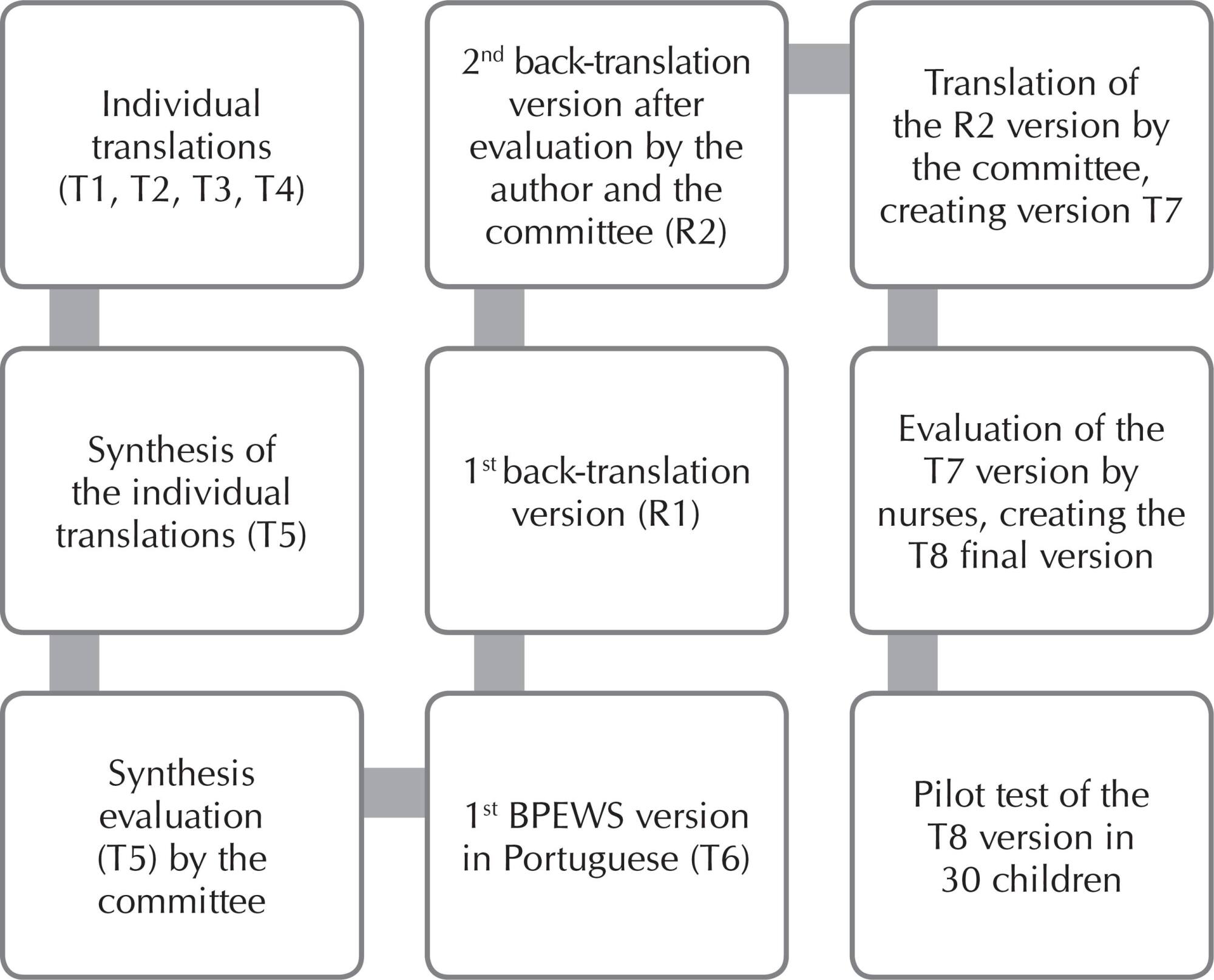
-
01-01-2016
Validation of the Nursing Activities Score in Portuguese intensive care units
Revista Brasileira de Enfermagem. 2016;69(5):881-887
Abstract
Validation of the Nursing Activities Score in Portuguese intensive care units
Revista Brasileira de Enfermagem. 2016;69(5):881-887
DOI 10.1590/0034-7167-2016-0147
Views0See moreABSTRACT
Objective:
to describe the process of adaptation and validation of the Nursing Activities Score to the Portuguese context.
Method:
this was a pilot study of adaptation and validation of the Nursing Activities Score with a sample consisting of 67 patients hospitalized in the intensive care units of three Portuguese hospitals. The construct validity was assessed through factor analysis procedures and the internal consistency of the items was measured through the Cronbach’s alpha coefficient.
Results:
a mean workload value of 63.04% (SD = 14.25; Median = 61.30) was obtained. Psychometric data revealed a Cronbach’s alpha of 0.71 in the total scale, indicating an acceptable accuracy. Confirmatory factor analysis suggested an appropriate adjustment between the model and the data (χ2(199) = 214.5, p = 0.214; CFI = 0.95; RMSA = 0.035).
Conclusion:
in the present study, the Portuguese version of the Nursing Activities Score was found to be a valid instrument, enabling a safe assessment of the workload of nurses.
-
01-01-2016
Managing educational practices for qualified nursing care in cardiology
Revista Brasileira de Enfermagem. 2016;69(5):872-880
Abstract
Managing educational practices for qualified nursing care in cardiology
Revista Brasileira de Enfermagem. 2016;69(5):872-880
DOI 10.1590/0034-7167-2015-0032
Views0See moreABSTRACT
Objective:
to understand significances attributed by nurses who manage nursing care to the individual affected by cardiovascular disease to relations, interactions and associations of the educational practices in a cardiovascular reference hospital. To elaborate a theoretical explanatory model based on significances attributed in the light of the complex thinking.
Method:
qualitative study, which used Theory Based on Data (TBD) as methodological reference. Twenty-two professionals of nursing participated in the study.
Results:
the results indicate need of professional qualification to ensure the safety of patients, institutional support for the realization of educational practices, attitude of openness and availability of dialogue of the health professionals and other institutional conformations for the workers’ development.
Conclusion:
the study presents a new space for the nurse’s action that can be used to qualify and optimize the nursing practice, as it provides visibility to management and care in health institutions.
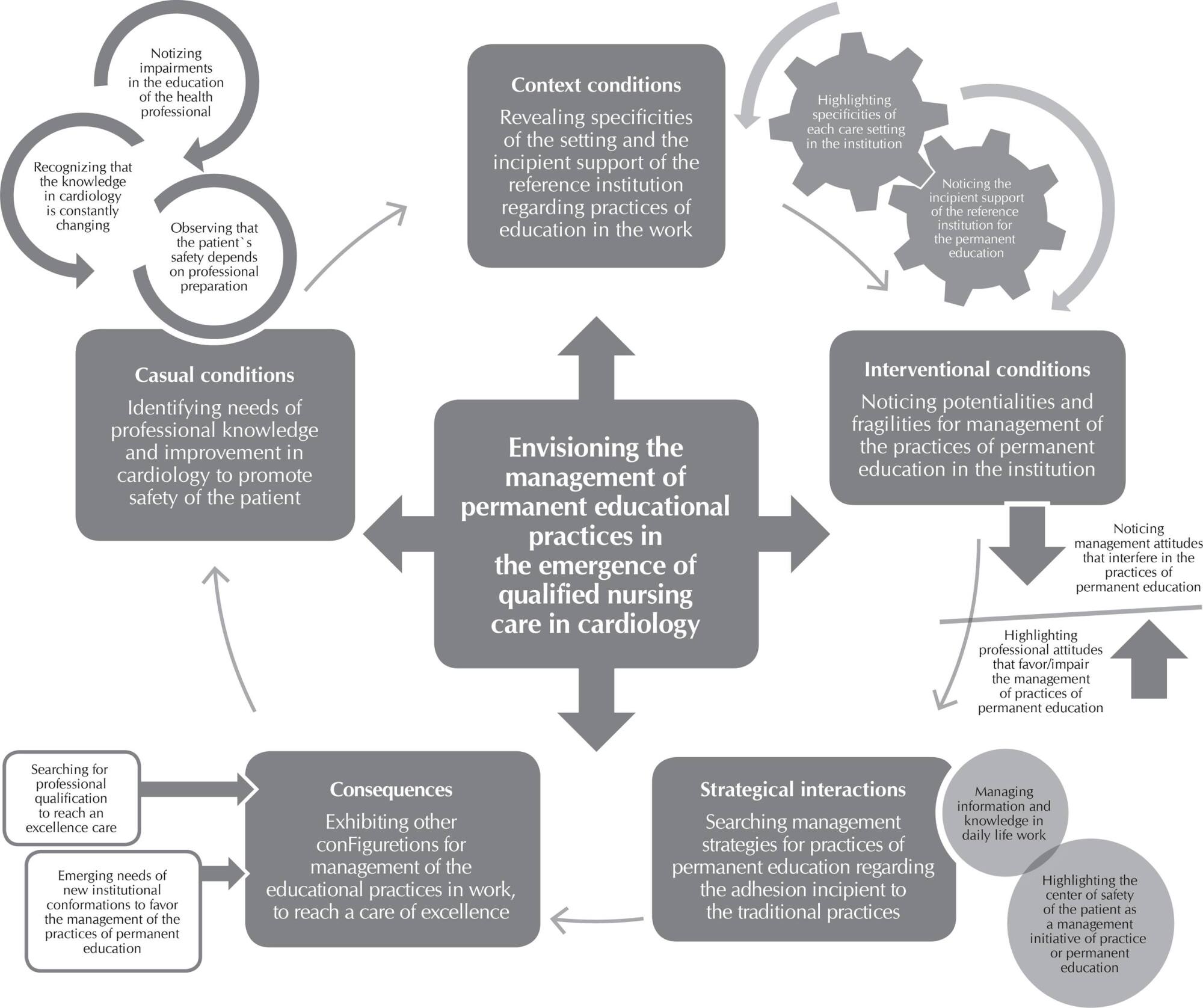
-
01-01-2016
Social representations of biosecurity in nursing: occupational health and preventive care
Revista Brasileira de Enfermagem. 2016;69(5):864-871
Abstract
Social representations of biosecurity in nursing: occupational health and preventive care
Revista Brasileira de Enfermagem. 2016;69(5):864-871
DOI 10.1590/0034-7167-2015-0114
Views0See moreABSTRACT
Objective:
to understand the biosecurity social representations by primary care nursing professionals and analyze how they articulate with quality of care.
Methods:
exploratory and qualitative research based on social representation theory. The study participants were 36 nursing workers from primary health care in a state capital in the Northeast region of Brazil. The data were analyzed by descending hierarchical classification.
Results:
five classes were obtained: occupational accidents suffered by professionals; occupational exposure to biological agents; biosecurity management in primary health care; the importance of personal protective equipment; and infection control and biosecurity.
Conclusion:
the different positions taken by the professionals seem to be based on a field of social representations related to the concept of biosecurity, namely exposure to accidents and risks to which they are exposed. However, occupational accidents are reported as inherent to the practice.
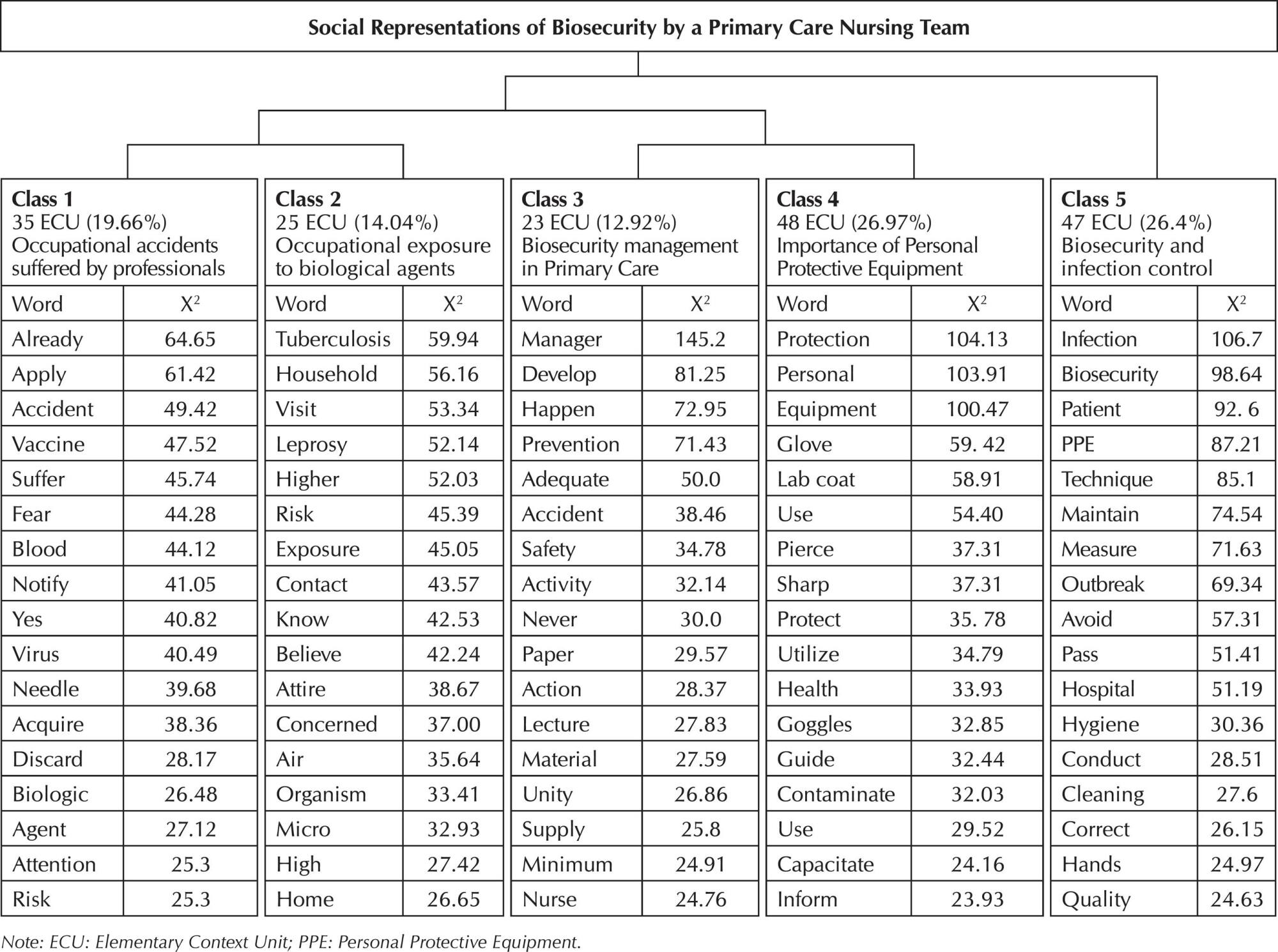
-
01-01-2016
Clinical validation of nursing diagnosis “Willingness for improved infant development”
Revista Brasileira de Enfermagem. 2016;69(5):855-863
Abstract
Clinical validation of nursing diagnosis “Willingness for improved infant development”
Revista Brasileira de Enfermagem. 2016;69(5):855-863
DOI 10.1590/0034-7167-2015-0131
Views0See moreABSTRACT
Objective:
to conduct the clinical validation of nursing diagnosis “Willingness for improved infant development”.
Method:
a cross-sectional study, conducted in a Centro de Saúde da Família (Family Health Care center), with 45 healthy breastfed infants. The instrument for collecting the data was prepared based on the literature and validated by nurses. It contained the following variables: sociodemographic, gestational, and obstetrical variables; breastfed infant’s nutritional profile; evaluation of the defining characteristics of the proposed nursing diagnosis.
Results:
all the defining characteristics were found to have high sensitivity values (>90%), positive predictive values (>65%), negative predictive values (>66%); however, low specificity values (<32%). In this study, the defining characteristics we found to have estimates (>0.50) within the ROC curve, which provides good sensitivity and specificity.
Conclusion:
this study verified the structural elements of the proposed nursing diagnosis to be relevant in the clinical context, which justifies the need for its being employed with children, taking into account its contribution to improving nursing care.
-
01-01-2016
Oral drugs at a hospital unit: adequacy for use via enteral feeding tubes
Revista Brasileira de Enfermagem. 2016;69(5):847-854
Abstract
Oral drugs at a hospital unit: adequacy for use via enteral feeding tubes
Revista Brasileira de Enfermagem. 2016;69(5):847-854
DOI 10.1590/0034-7167-2015-0081
Views0See moreABSTRACT
Objective:
to describe the profile of standardized oral drugs at a hospital unit and assess their adequacy for use via enteral feeding tubes, according to recommendations from the literature.
Method:
descriptive study, with data on drugs collected from the Pharmacy Service Dispensing System. Specific recommendations for the use of these drugs via enteral feeding tubes were found after searches in literary databases, books, manuals, guidelines and package insert collections.
Results:
among the 236 dispensed oral drugs, 86% were in solid form; of those, 32 were “non-crushable”, with the liquid form available at the institution. Twenty-eight drugs with potential interactions with enteral nutrition were identified. Sixty percent of those presented specific recommendations on their administration via enteral feeding tube.
Conclusion:
the joint participation of multidisciplinary nutritional therapy and care teams and the implementation of programs for continuous training are suggested strategies for the prevention of potential problems in the administration of drugs in the hospital setting.
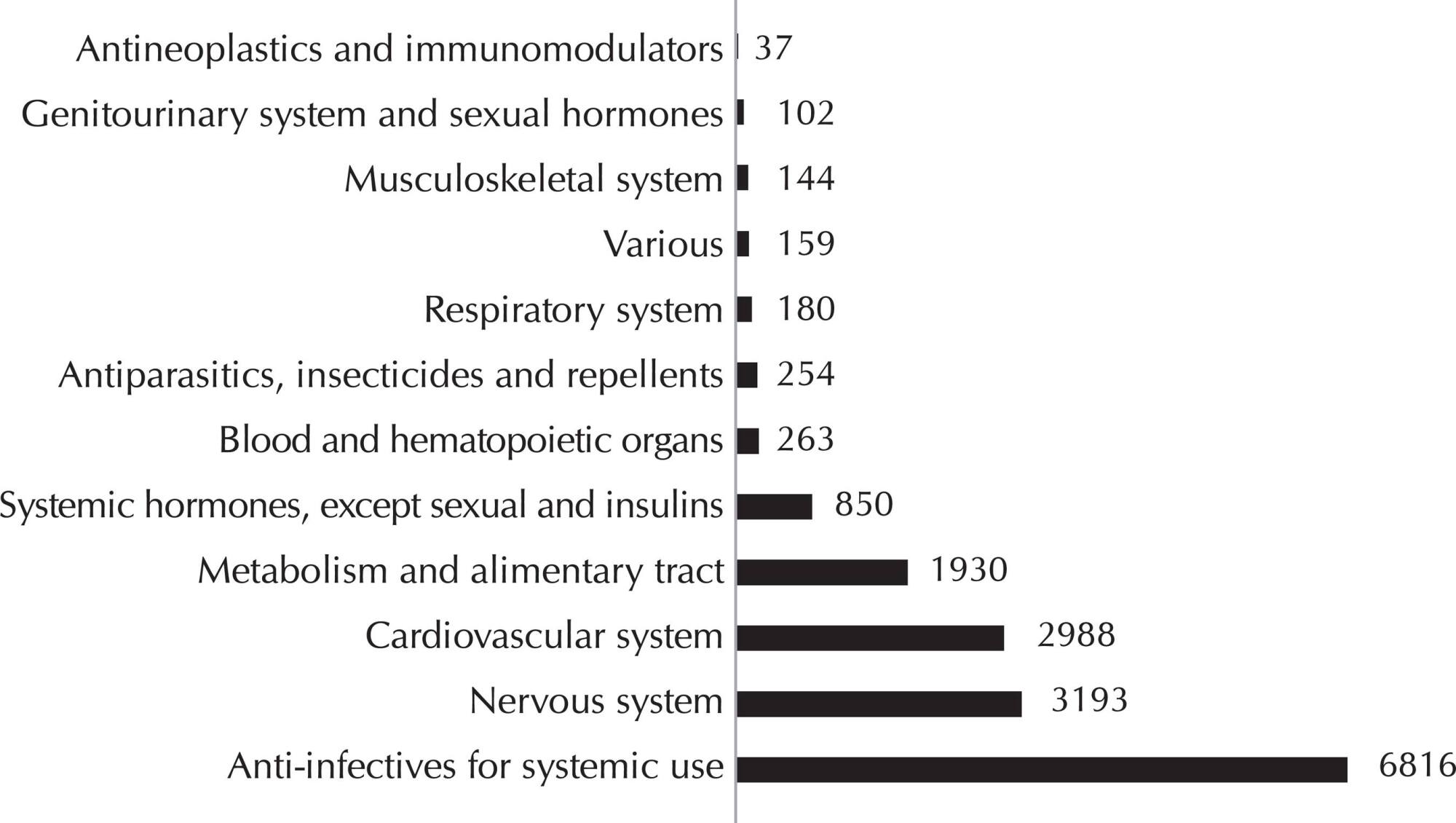
-
ORIGINAL ARTICLE09-21-2020
Family management ofchildren who experience sickle cell disease: a qualitative study
Revista Brasileira de Enfermagem. 2020;73:e20190521
Abstract
ORIGINAL ARTICLEFamily management ofchildren who experience sickle cell disease: a qualitative study
Revista Brasileira de Enfermagem. 2020;73:e20190521
DOI 10.1590/0034-7167-2019-0521
Views1See moreABSTRACT
Objective:
to know the family management experience of children with sickle cell disease in the light of the Family Management Style Framework.
Methods:
a qualitative case study carried out between September/2015 and July/2016 with 12 members of eight families registered in a blood center in Minas Gerais. The semi-structured interviews were recorded, and the data were analyzed and interpreted by the hybrid model thematic analysis.
Results:
three management styles were identified: five families in the accommodating style; two families in the struggling style; and only one family in the enduring style.It was noted that empowerment was paramount in the acquisition of skills and abilities to care for these children.
Final considerations:
family management knowledge of children with sickle cell disease provided a reflection on nurses’ role in supporting, orienting and encouraging the empowerment of these families aiming at the search for comprehensive care.
-
ORIGINAL ARTICLE09-16-2019
Spatial analysis on tuberculosis and the network of primary health care
Revista Brasileira de Enfermagem. 2019;72(5):1197-1202
Abstract
ORIGINAL ARTICLESpatial analysis on tuberculosis and the network of primary health care
Revista Brasileira de Enfermagem. 2019;72(5):1197-1202
DOI 10.1590/0034-7167-2017-0897
Views1See moreABSTRACT
Objective:
to analyze the spatial distribution of new cases of tuberculosis compared to the location of the Primary Healthcare Units that performed the compulsory notification.
Method:
ecological study conducted in Belém, Pará, with 5,294 new cases of tuberculosis notified to Sistema de Informação de Agravos de Notificação for the period from 2010 to 2014. The cases were georeferenced using the software applications ArcGis 10.2 and TerraView 4.2.2. The techniques of Kernel density and global Moran geostatistics were used.
Results:
the incidence of tuberculosis cases did not vary significantly between the years studied, however there was a variation in incidence between neighborhoods. Health units that exhibited higher number of notifications can suffer great influence of migration from nearby neighborhoods.
Conclusion:
the spatial dynamics of tuberculosis associated with health services allows to know the areas with increased risk of tuberculosis and the density of notifications of health units.
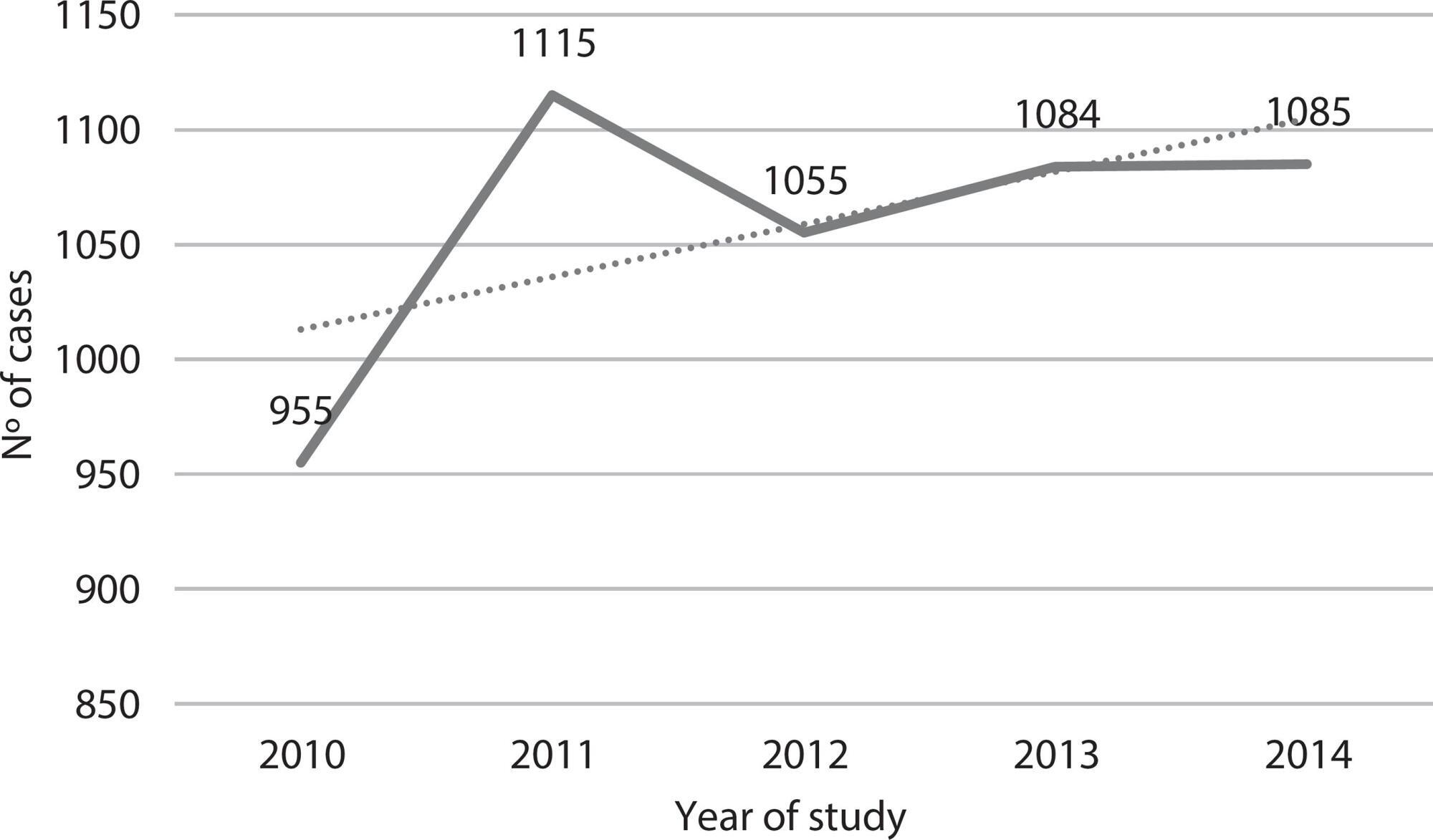
-
04-16-2021
Questionnaire for assessing patient safety culture in emergency services: an integrative review
Revista Brasileira de Enfermagem. 2021;74(2):e20190693
Abstract
Questionnaire for assessing patient safety culture in emergency services: an integrative review
Revista Brasileira de Enfermagem. 2021;74(2):e20190693
DOI 10.1590/0034-7167-2019-0693
Views0See moreABSTRACT
Objective:
to identify the instruments used to assess patient safety culture in emergency settings.
Method:
an integrative literature review conducted from 2000 to 2018.
Results:
13 instruments were identified to assess patient safety culture in hospital and pre-hospital emergencies, comprising 12 to 50 questions, grouped from three to 12 dimensions, with dimensions related to teamwork, support, and management actions for patient safety and for continuous process improvement and continuing education. The Emergency Medical Service Safety Attitude Questionnaire, which is exclusive for pre-hospital care, stands out.
Conclusions:
the choice and the best decision regarding the instrument are linked to the objectives, the environment and the population to be investigated, as well as the instrument’s reliability.
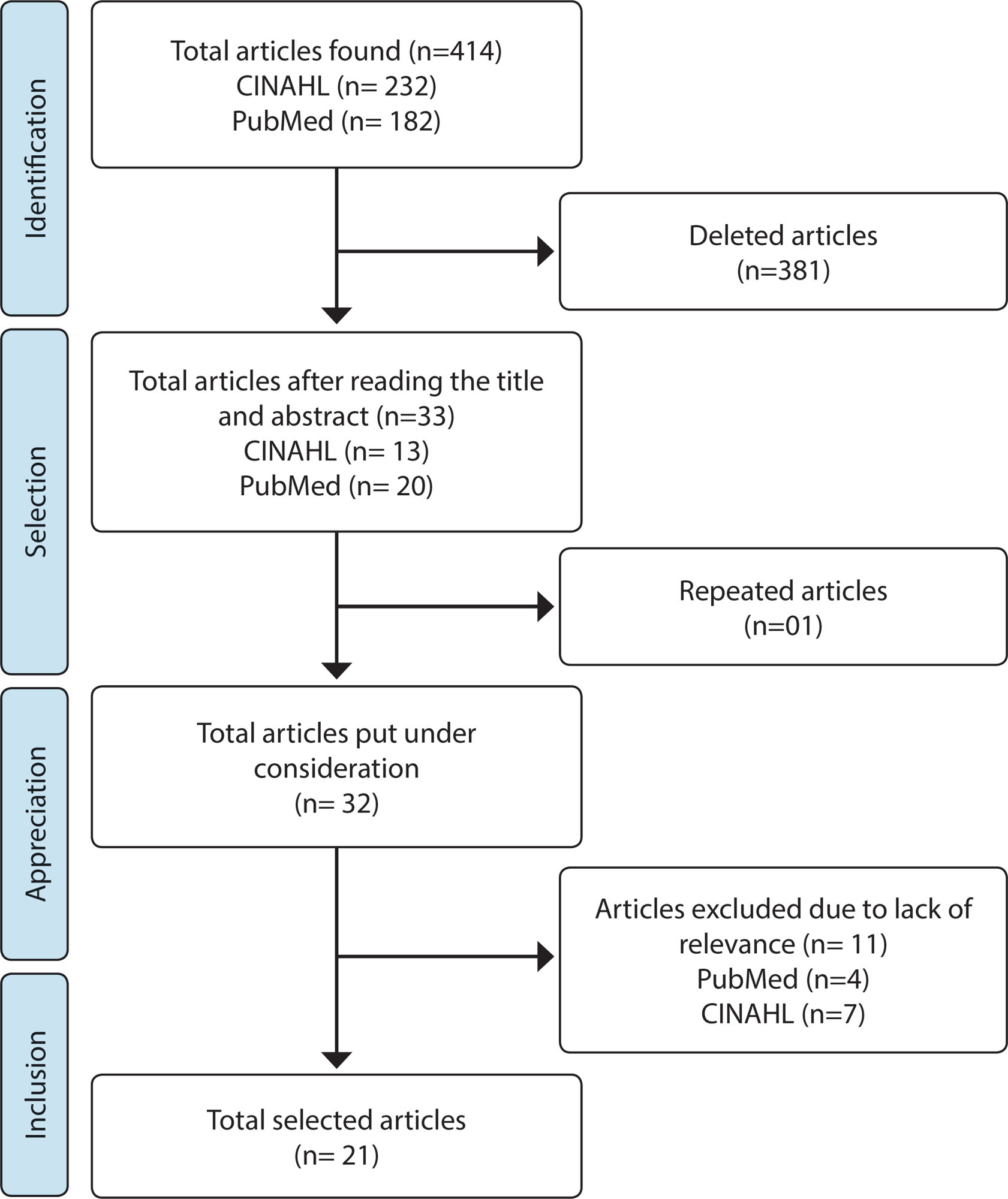
-
05-21-2021
Pleasure and suffering in the work of nurses at the oncopediatric hospital unit: qualitative research
Revista Brasileira de Enfermagem. 2021;74:e20200735
Abstract
Pleasure and suffering in the work of nurses at the oncopediatric hospital unit: qualitative research
Revista Brasileira de Enfermagem. 2021;74:e20200735
DOI 10.1590/0034-7167-2020-0735
Views0See moreABSTRACT
Objective:
To analyze the experiences that generate pleasure and suffering in the work of nurses in an oncopediatric inpatient unit.
Methods:
Qualitative, exploratory, descriptive study. Data collection took place from March to May 2018, through interviews with eight nurses in an oncopediatric inpatient unit.
Results:
The verbalized experiences of pleasure were the work developed with children, participation in the treatment and cure of patients and the recognition of family members in relation to the work performed. The suffering experiences were palliative care and death of patients, performing invasive procedures and organizing work.
Final considerations:
It was possible to analyze the experiences of pleasure and suffering of nurses in an oncopediatric unit through the psychodynamics of work, allowing to reinvent prevention and intervention measures by managers in health/mental illness processes at work.
-
REVIEW09-21-2020
Postnatal care of newborns in the family context: an integrative review
Revista Brasileira de Enfermagem. 2020;73:e20190454
Abstract
REVIEWPostnatal care of newborns in the family context: an integrative review
Revista Brasileira de Enfermagem. 2020;73:e20190454
DOI 10.1590/0034-7167-2019-0454
Views0See moreABSTRACT
Objective:
to analyze the postnatal care practices of newborns in the family context from the scientific literature.
Methods:
the searches of the integrative literature review were carried out in the Latin American and Caribbean Literature in Health Sciences (LILACS), Nursing Database (BDENF), Scientific Electronic Library Online (SciELO), and U.S. National Library of Medicine (PubMed) databases.
Results:
sixteen studies composed the final sample and, from these, two analytical categories emerged: Practices and doubts of families in postnatal care of newborns; and Best practices in postnatal care of newborns.
Final considerations:
several cultural practices of families differ from scientific recommendations, which can generate risks to the health of newborns. Therefore, it is essential to consolidate educational programs with family members, to improve the quality of care offered and to reduce preventable neonatal deaths in different socio-family contexts.

-
ORIGINAL ARTICLE03-07-2022
Predictors of frailty in older people users of Primary Health Care
Revista Brasileira de Enfermagem. 2022;75:e20201292
Abstract
ORIGINAL ARTICLEPredictors of frailty in older people users of Primary Health Care
Revista Brasileira de Enfermagem. 2022;75:e20201292
DOI 10.1590/0034-7167-2020-1292
Views0See moreABSTRACT
Objective:
to identify the prevalence and predictors of frailty in older people in Primary Health Care.
Method:
this is a descriptive and correlational study, carried out in a convenience sample of 136 older people in the community. Data were collected through a sociodemographic and clinical questionnaire and frailty phenotype. Student’s t test or U-Mann-Whitney test, chi-square and binary logistic regression were used for data analysis.
Results:
the prevalence of frailty was 26.5% (n=36). Frail individuals had older age (p=0.011), worse self-rated health (p=0.001) and lower physical capacity (p<0.001). In the multivariable regression, it was observed that frail individuals had older age (Odds Ratio=1.111; 95% confidence interval=1.026-1.203) and worse physical capacity (Odds Ratio=0.673; 95% confidence interval=0.508-0.893).
Conclusions:
the prevalence of frailty in older people in Primary Health Care was considerable. Advanced age and worse physical capacity were the most relevant predictors of frailty in the elderly.
-
REFLECTION03-24-2021
Workplace violence: legislation, public policies and possibility of advances for health workers
Revista Brasileira de Enfermagem. 2021;74(1):e20200335
Abstract
REFLECTIONWorkplace violence: legislation, public policies and possibility of advances for health workers
Revista Brasileira de Enfermagem. 2021;74(1):e20200335
DOI 10.1590/0034-7167-2020-0335
Views0See moreABSTRACT
Objectives:
to discuss specific laws and public policies for workplace violence in the health sector, highlighting possibilities for the collective confrontation of this phenomenon in Brazil.
Methods:
this is a reflective and argumentative study that refers to some previous experiences regarding the implementation of legal aspects to curb workplace violence directed at health professionals.
Results:
there are experiences regarding the existence of legislation or public policies to specifically contain workplace violence in the health sector, but these are still restricted to some places or countries. The literature provides resources for developing specific strategies for managing this phenomenon, highlighting prevention programs and conducts for case management.
Final Considerations:
implementation of legal aspects or public policies at the municipal, regional, state and/or national level is a strategy with potential to confront workplace violence in health services in a collective and sustainable way.
-
09-16-2019
Tuberculosis: knowledge among nursing undergraduate students
Revista Brasileira de Enfermagem. 2019;72(5):1279-1287
Abstract
Tuberculosis: knowledge among nursing undergraduate students
Revista Brasileira de Enfermagem. 2019;72(5):1279-1287
DOI 10.1590/0034-7167-2018-0384
Views0See moreABSTRACT
Objective:
To analyze the knowledge about tuberculosis among nursing undergraduate students of a Federal Higher Education Institution.
Method:
Descriptive cross-sectional study, with quantitative approach. Data were collected through a questionnaire based on the WHO’s guide to developing evaluation instruments on knowledge, attitudes and practices related to TB. Students were classified as “with knowledge” and “with little knowledge” based on the mean percentage of correct responses to the variables analyzed. Descriptive statistics techniques were used.
Results:
60 nursing students were interviewed. “with little knowledge” was observed among students who were studying at the university for less time and who had no previous contact with the subject, and “with knowledge” was observed among those whose knowledge about tuberculosis was acquired in the health services.
Conclusion:
Knowledge gaps among undergraduate nursing students were identified, suggesting the need to rethink teaching-learning strategies on the subject.
Search
Search in:
Nuvem de Tags
Adolescente (85) Atenção Primária à Saúde (239) COVID-19 (91) Criança (91) Cuidados de Enfermagem (269) Educação em Enfermagem (151) Educação em Saúde (139) Enfermagem (930) Enfermagem Pediátrica (86) Estudantes de Enfermagem (77) Estudos de Validação (131) Família (87) Idoso (208) Promoção da Saúde (99) Qualidade de Vida (104) Saúde do Trabalhador (86) Saúde Mental (145) Saúde Pública (82) Segurança do Paciente (150) Tecnologia Educacional (100)



